Monitor Your Horse’s Health Easier than Ever with the Photo Upload Feature
Watch this quick video on how to use FeedXL’s Photo Upload feature! Track your horse’s health and progress with this quick and easy tool.
Watch this quick video on how to use FeedXL’s Photo Upload feature! Track your horse’s health and progress with this quick and easy tool.
As we all know, keeping horses can be expensive, and feed and supplement costs can quickly add up. But with FeedXL, you can easily monitor your diet-specific daily, monthly, and annual costs using the ‘Add Costs’ function.
And once you’ve got costs added for each of the products you use you can use Feed Finder and Supplement Finder to compare the cost of adding these to your diets. It can be a real eye-opener and result in significant savings. This is just another way that FeedXL can help you and your horse on your equine nutrition journey, by feeding better, safer, and smarter.
Check out this video tutorial presented by Eira from our Nutrition Team:
FeedXL is a combination of NRC nutrient requirements and customised nutrient requirements based on our own research as well as information taken from the most recent and comprehensive text on equine nutrition, ‘Equine Applied and Clinical Nutrition’1
In brief, digestible energy is always determined as per NRC requirements as we could find no evidence to support adjusting it from the levels determined by NRC. In practice, DE requirement for an individual horse is an estimate. Many factors, including climate, level of natural exercise the horse undertakes and the actual diet and how efficiently or inefficiently it is digested will impact a horse’s actual DE requirement.
Crude protein and lysine are set as per NRC for pregnant & lactating mares, spelling and lightly worked horses and growing horses. But we slightly elevate both crude protein and lysine requirements for horses in moderate to heavy work as well as breeding stallions. We are perhaps a little conservative on protein and lysine but also see good evidence in practice to show that when crude protein and lysine requirements are met using high quality protein sources we are able to support pregnancy and lactation without the loss of muscle in broodmares and we get well grown and developed yearlings and 2 year olds, allowing us to conclude that the NRC requirements where used are adequate… provided the underlying diet is well formulated.
Calcium and phosphorus requirements are elevated across the board above NRC requirements and are closely aligned with the requirements set by Prof Pat Harris1
Copper, zinc and manganese are similarly elevated across the board from NRC with the exception of spelling horses that are calculated as per NRC requirements. The largest elevations are seen in the growing horse and pregnant mare diets in an attempt to reduce the risk of developmental orthopaedic diseases like OCD.
Selenium is elevated above the NRC requirement. The NRC state that their recommended daily intake for selenium is the level required to prevent classic deficiency symptoms and that more is potentially useful to maintain more optimal immune function. Thus FeedXL uses an elevated selenium requirement that aligns closely with Geor et al1.
FeedXL follows the NRC recommended daily intake for iodine for all classes of horses.
Iron follows the NRC recommended daily intakes for all horses except those in moderate, heavy and very heavy work where requirement is elevated to account for iron lost in sweat.
Sodium, chloride and magnesium largely follow the NRC requirements. There are some small variations, with growing horses sodium requirements being slightly higher than NRC and magnesium being higher for pregnant and lactating mares.
Potassium requirements are higher than NRC across the board but this was more from a practical ‘user interpretation’ standpoint in FeedXL. Because forages are so high in potassium, if we used the NRC recommended daily intake for potassium, we would see several hundred times the required amount in diets and this was worrying for our FeedXL users. Because potassium is so safe we have elevated the requirement to reduce the amount of worry for people analysing diets. In over 20 years of formulating diets we have not seen a potassium deficiency, even with our elevated requirement, nor is it necessary in all but very unusual cases to add potassium to diets.
Very little is actually known about vitamin A requirements in horses. In FeedXL, Vitamin A requirements are guided by Geor et al with Vitamin A elevated across the board from NRC requirements. Likewise vitamin E levels follow a similar trend.
Vitamins D, B1 and B2 are as per NRC requirements.
Vitamins B5, B6, niacin and folic acid are calculated based on small amounts of research in horses as well as humans, rats and pigs. The recommendations for these vitamins are relatively conservative because there are no established NRC equine requirements, but they serve to ensure diets are meeting what we estimate to be the likely dietary requirement for horses.
We would love to welcome you to our FeedXL Horse Nutrition Facebook Group. Ask questions and have them answered by PhD and Masters qualified equine nutritionists and spend time with like-minded horse owners. It’s free!
Click here to join the FeedXL Horse Nutrition Facebook Group
Let’s take a look at two common mistakes horse owners make: underfeeding and overfeeding.
Underfeeding can lead to health and performance issues because certain nutrients are not being met.
Overfeeding is where you are supplying more than you need of multiple nutrients. At best, overfeeding is a WASTE OF MONEY! At worst, it will cause nutrient toxicity and can make your horse very sick!
One of the most important reasons you use a tool like FeedXL is to identify and correct nutrient deficiencies in the diet that result from ‘underfeeding’.
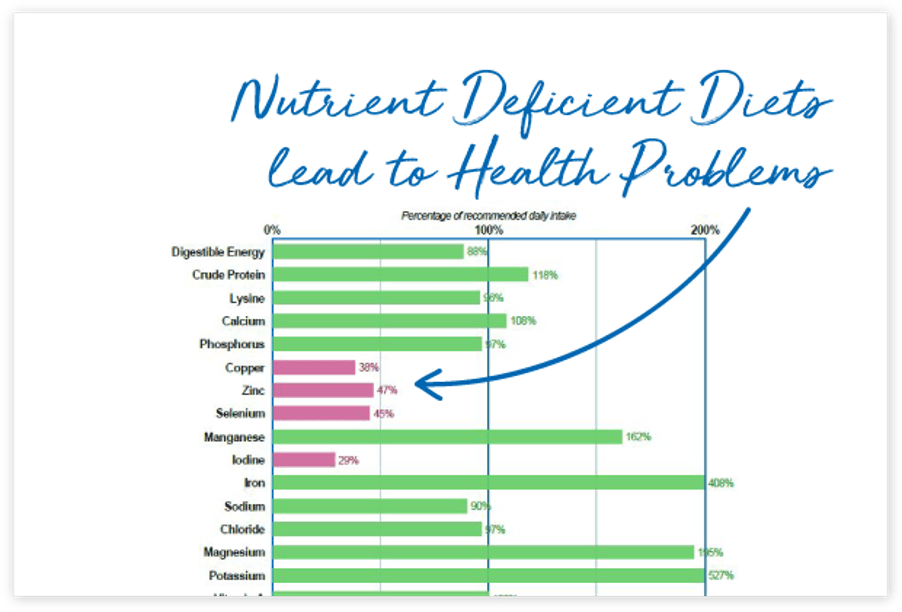
Common mineral deficiencies include copper, zinc, selenium and iodine while common vitamin deficiencies include vitamin E and vitamin B1.
These deficiencies can have pretty dramatic long-term consequences for your horse including slow wound repair, gastrointestinal damage, poor immune response, hooves and joints that fall apart, muscle damage, especially during exercise, poor behaviour, muscle wastage and weight loss.
If the deficiencies are severe, diseases like severe neuromuscular disorders can occur.
It’s REALLY important to meet your horse’s needs for all of these nutrients! So we are really glad you are here.
Your first task with FeedXL should be to assess your horse’s current diet.
To do this, simply enter you horse with as accurate information as possible.
Once your horse is entered, choose or enter your pasture or free choice hay (and if you get stuck at this step be sure to jump on live chat and ask us for help!).
Then, enter your horse’s feeds and supplements as accurately as possible… we highly recommend grabbing yourself a small set of scales to weigh any feeds and supplements. Plus a set of luggage scales to weigh your hay!
Next, you go to the results page and here you will see which of your horse’s requirements are met and which are not!
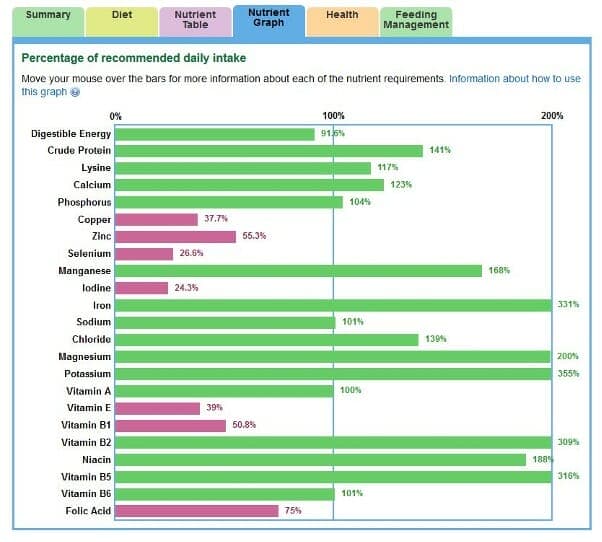
And at this point it is interesting to ponder whether any issues you may have been having with your horse are due to any of the deficiencies you may have found.
You might also like to head over to our FeedXL Horse Nutrition Facebook Group and discuss what you found with your fellow members!
First, if you are underfeeding, you can try increasing the amounts of the feeds or supplements you are already using in the diet. If you increase them, does this fill all the gaps in your horse’s diet?
But keep in mind if you increase a feed too much you may just make your horse fat, which means this isn’t a good option… what works in this situation? It’s best to add a supplement or balancer pellet.
It is so worth the effort to find these deficiencies in your horse’s diet because they could explain a lot about your horse’s health, appearance and behaviour!
Next, let’s look at overfeeding…
Overfeeding is where you are supplying more than you need of multiple nutrients.
It usually happens when you add supplements on top of feeds on top of supplements! It’s how we feed when we are ‘unsure’ if we are giving our horses everything they need!
At best, overfeeding is a WASTE OF MONEY!
At worst, it will cause nutrient toxicity and can make your horse very sick!
So in the same process as we went through before, if you haven’t already, enter your horse’s current diet and look for any nutrient excesses. (Log in here or sign up if you’re not yet a member).
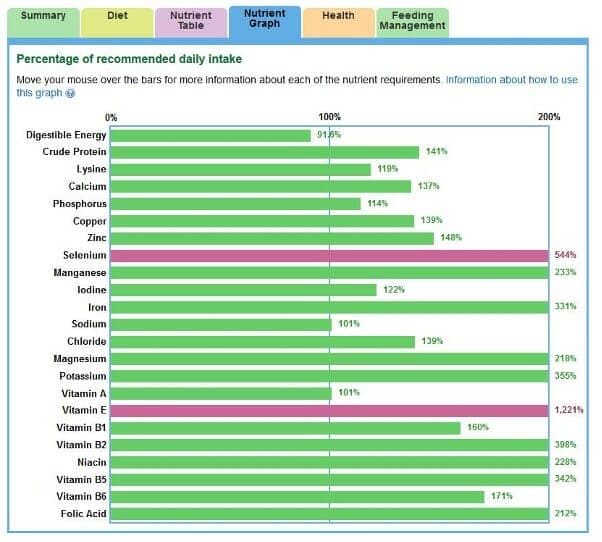
Are you feeding well above what your horse needs for some nutrients, are there any nutrient toxicities, could you reduce some of the feed or supplement amounts to reduce these excesses?
If you are not sure where it is best to have some nutrient levels and what is ‘normal’ (because you will never get a diet where everything sits at 100%), I highly recommend reading this article: ‘Do you need to get every nutrient to 100% on the FeedXL graph?‘.
One of the most common pieces of feedback we get from our members centres around saving money by not overfeeding.
If you are overfeeding, try reducing the amount of the feeds and/or supplements in the diet. If you decrease them, can you bring the levels of nutrients down to where they should be (and again if you’re not sure, refer to ‘Do you need to get every nutrient to 100% on the FeedXL graph?‘) WITHOUT creating any nutrient deficiencies.
If neither of those options work, you can try a couple of things.
You could add another feed or supplement on top of the ones you already have to fill in the gaps.
In some cases this is a good option. For example, your diet may be a little low on vitamin E… it is very easy to just add a vitamin E supplement (you can find these in the blue ‘Balancers and Supplements’ tab under ‘Antioxidants’).
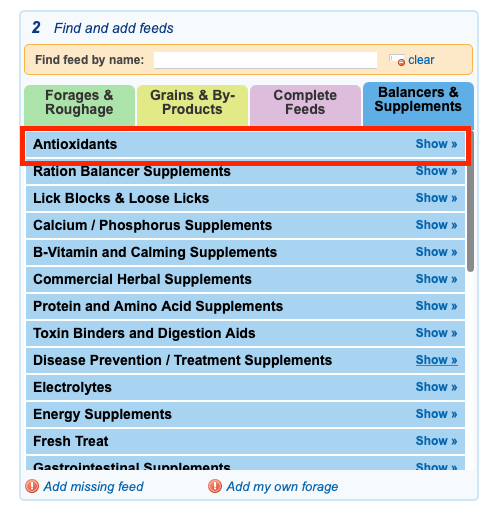
But in a lot of cases adding a second feed or supplement may not be the best option.
For example if you are already using a vitamin & mineral supplement but still have deficiencies in the diet, it is a waste of money using this ‘unbalanced supplement’ and fixing it with still more supplements.
If this is your situation, I would suggest taking the unbalanced supplement OUT of the diet and completely and replacing it with a more balanced one, so that you can use one product.
It’s just a matter of finding the perfect supplement to balance your horse’s diet!
By far the easiest way to do this is by using our ‘Find Supplements to Fix this Diet’ button. When you click this button, FeedXL will sort through EVERY ONE of the thousands of supplements in its database and find the best ones to fit your horse’s diet.
Check out how the supplement finder works here.
It is so worth doing the work on your horse’s diet, because you can improve your horse’s health, appearance and performance PLUS save yourself some money.
Go spend some time seeing if you can reduce or even remove some products from your horse’s diet and still keep it balanced!
Note: If you are still on the BASIC plan in FeedXL you will discover that this feature is not available on our Basic plan… upgrade for access to the supplement finder (definitely your best option as these tools supercharge how useful and easy to use FeedXL is!).
You can also head over to our FeedXL Horse Nutrition Facebook Group and ask your fellow members for recommendations for supplements that have balanced diets similar to yours. Be sure to give them some basic details of your horse and diet (screen shots from FeedXL work well) AND also your location in the world so the recommendations are relevant 😊.
Of course then you should put them into your diet to check how well they work with yours.
If you are using a feed that is not balanced the same process applies, you can use the ‘Find Feeds to Fix this Diet’ button (check it out here) OR you can ask for recommendations from your fellow members!
And remember if you are really stuck we are here to help! For quick questions you can catch us via email (support@feedxl.com) or live chat (look for the icon in the bottom right of FeedXL when you are logged in).
If you’d like more detailed help, you can book a one-on-one consult with one of our team of nutritionists!
This may sound and feel a bit overwhelming, but just take your time, ask us lots of questions when you need to and lean on your fellow members and we will have you balancing diets superfast in no time!!
We would love to welcome you to our FeedXL Horse Nutrition Facebook Group. Ask questions and have them answered by PhD and Masters qualified equine nutritionists and spend time with like-minded horse owners. It’s free!
Click here to join the FeedXL Horse Nutrition Facebook Group
Forage is the Single. Most. Important component of your horse’s diet… for a whole bunch of reasons!
So it’s REALLY important to have ENOUGH forage in your horse’s diet and it’s also a wonderful idea to have a VARIETY of forage in the diet.
Here’s what that will look like: 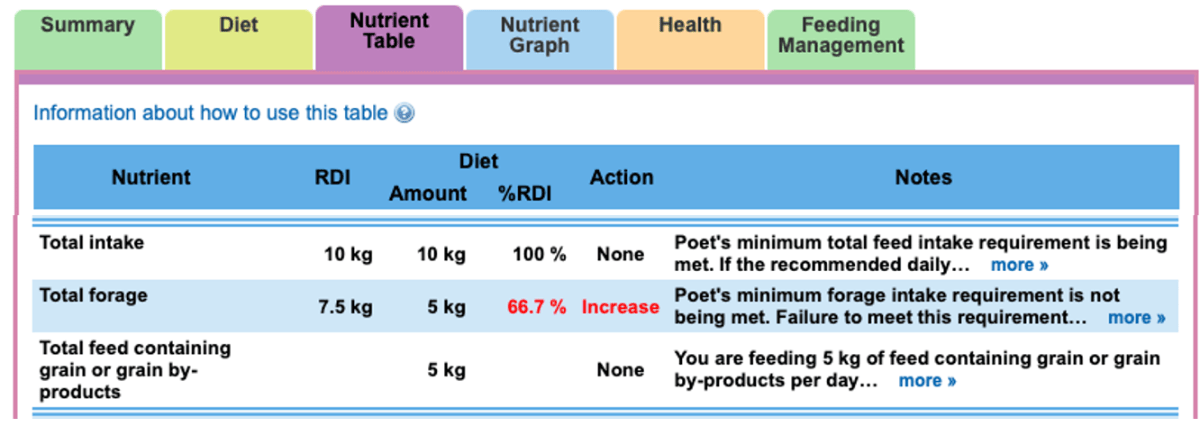 So be sure to meet the minimum daily forage requirement! Then our very best advice is, don’t stop there!
So be sure to meet the minimum daily forage requirement! Then our very best advice is, don’t stop there!
The more forage you can get into your horse’s diet, the better! So here is a tip… in FeedXL, enter all of your horse’s forages, pasture, hay, chaff, forage cubes or pellets, haylage… anything that is considered forage! Then go to the results and look at your horse’s ‘Total Daily Feed Intake’ amounts. Is it at 100%? Or is it less than 100%? 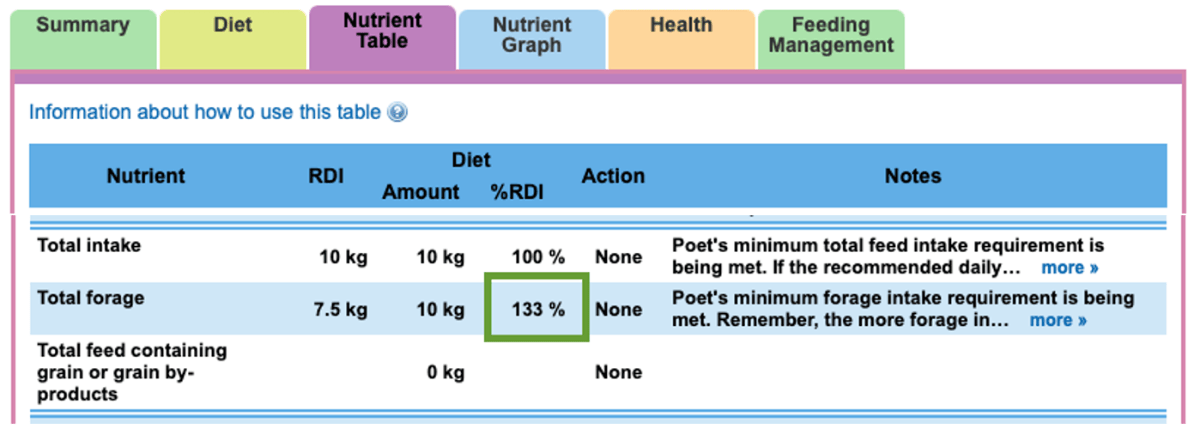 If it is at 100% or above (extra stars for above!), look at your horse’s nutrient graph, looking specifically at the Digestible energy level. Is it between 90 and 100%?
If it is at 100% or above (extra stars for above!), look at your horse’s nutrient graph, looking specifically at the Digestible energy level. Is it between 90 and 100%?  If it is, and ALL you have in the diet is FORAGE this means forage can be used to meet 100% of your horse’s daily Digestible Energy (calorie) requirements and you are unlikely to need a feed!
If it is, and ALL you have in the diet is FORAGE this means forage can be used to meet 100% of your horse’s daily Digestible Energy (calorie) requirements and you are unlikely to need a feed! 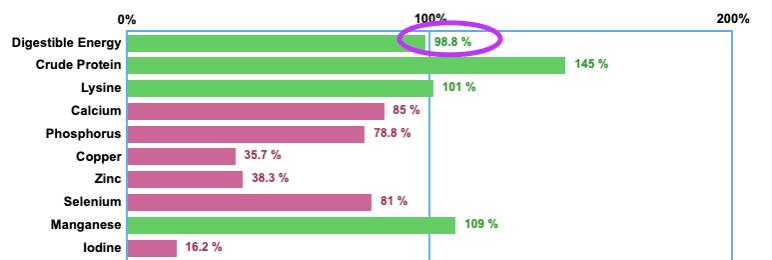 (You will however still need to add a supplement to top up mineral and some vitamin levels and may need to add some high quality protein – more on this here.)
(You will however still need to add a supplement to top up mineral and some vitamin levels and may need to add some high quality protein – more on this here.)
This high forage diet, especially if it contains a variety of forage, is the closest diet you can get to a horse’s natural diet and will be the best in terms of gut and overall health for them! If your horse’s energy is too low (less than 90% OR your horse is currently losing weight on an all forage diet) then you will need to add some higher energy ingredients to the diet. But keep in mind that you still want to keep as much forage in the diet as you possibly can! Some suggestions for higher energy ingredients include sugarbeet pulp, copra meal, lupins, lupin hulls, higher energy forages like alfalfa/lucerne, oils and if they are safe for your horse, oats or other cereals (like corn/maize or barley) AS LONG AS THE GRAINS ARE COOKED! The trick is to add as little of these ingredients as possible in FeedXL to meet that digestible energy requirement so you keep as much of your forage in the diet as possible! So keep adding small amounts of your chosen high energy ingredients and keep checking your results to see when you have added enough energy.
If your horse is on free choice pasture or hay you will notice that as you add a new ingredient your horse’s pasture or free choice hay intake will go down as you ad other ingredients. For example if your horse’s free choice forage intake is 10 kg/day…  And then you add 0.5 kg/day of oats, free choice forage will go down to 9.5 kg/day…
And then you add 0.5 kg/day of oats, free choice forage will go down to 9.5 kg/day… 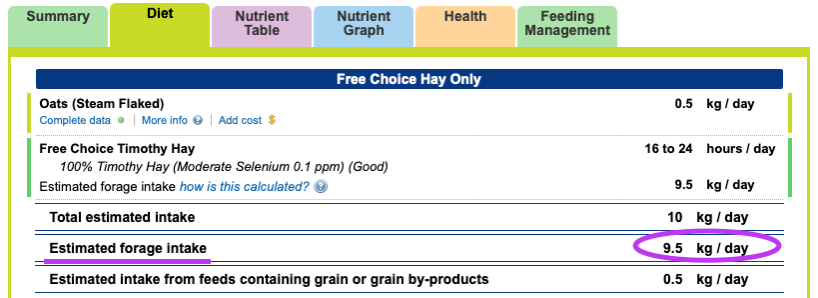
Because your horse only has so much room in its gut for feed each day. So as you increase in this example, oats in the diet, your free choice forage intake is reduced proportionally. Really hope that all helps! If you remember lots of forage PLUS a variety of forage your horse is going to be so far ahead in term of health and nutrition! If you have read this far, kudos to you! Big thanks for being here and remember if you have questions, just ask!
Want to learn more about including forage in your horse’s diet? Read our blog on how to balance forage needs with other nutritional requirements: Is Forage All a Horse Needs? (FeedXL.com)
We would love to welcome you to our FeedXL Horse Nutrition Facebook Group. Ask questions and have them answered by PhD and Masters qualified equine nutritionists and spend time with like-minded horse owners. It’s free!
Click here to join the FeedXL Horse Nutrition Facebook Group
Are you wasting money by feeding your horse unnecessary supplements? Maybe you thought that your horse isn’t getting enough of the most important nutrients, that maybe he’s missing something that could cause problems or even make him sick. So you feel like you should add a supplement or two or three, maybe your friend recommended something or you saw an advertisement that addressed a concern of yours, so you give him a bit of this and a bit of that just to make sure you’re covering everything. Does this sound familiar?
The problem here is that if you aren’t calculating your horse’s diet, you still aren’t sure if he’s getting the right amounts of the right things. And as we all know, the costs of supplements can quickly add up and become very expensive.
This is where FeedXL comes in – letting you feed with certainty because you know what you’re feeding is meeting requirements and you no longer need to add extras as a “just in case” insurance. With FeedXL, you can see exactly which requirements are met and which aren’t, and adjust your horse’s diet accordingly.
In the video below, we’ll go over a perfect example of this. With this diet, the owner has done a great job of putting together a high forage diet and with good intentions was using many supplements to ensure he was getting everything he needed. But watch as we’re able to completely remove nine unnecessary supplements and two feeds from his diet while still providing a diet that’s meeting all of his nutritional requirements at half the cost!
LOVING THIS CONTENT?
Get EVEN MORE practical and personalised feeding guidance when you sign up to FEEDXL.
We would love to welcome you to our FeedXL Horse Nutrition Facebook Group. Ask questions and have them answered by PhD and Masters qualified equine nutritionists and spend time with like-minded horse owners. It’s free!
Click here to join the FeedXL Horse Nutrition Facebook Group
Let’s discuss a common scenario – you want to maintain good bodyweight for your horse, so you’re feeding only enough to do just that. You’ve done your research and found feeds that you like and your horse is maintaining a healthy weight. You’re doing everything right, right?
Wrong. Did you know that even with high quality feeds, if you aren’t feeding the full recommended serving, your horse could be suffering from a vitamin or mineral deficiency?
Even if the amount being fed is enough to maintain your horse’s weight, if it isn’t enough to cover your horse’s vitamin and mineral requirements, this will eventually result in hoof, joint, performance, immune function and general health issues. The problem is that you won’t see that until something big happens.
Watch the video below as we walk through an example diet. This horse, Ash, has a lovely diet, except it doesn’t meet all of his nutritional requirements. With a few simple changes, FeedXL shows how to correctly balance the diet to meet all of his needs, including maintaining his weight.
Interested in learning more on this topic? Check out our blog on Underfeeding and Overfeeding – How to Tell and How to Fix It (FeedXL.com)
We would love to welcome you to our FeedXL Horse Nutrition Facebook Group. Ask questions and have them answered by PhD and Masters qualified equine nutritionists and spend time with like-minded horse owners. It’s free!
Click here to join the FeedXL Horse Nutrition Facebook Group
Forage based diets are the best! There are so many reasons why, if you can, you should feed diets that are close to 100% forage. But a hay-only diet is not enough. 95% + of the forages we see analysed don’t contain enough of one or more minerals to meet a horse’s requirement.
Plus, for horses in heavy work, lactating mares, and young, growing horses, forages often do not contain enough calories or protein to properly meet requirements.
And this is exactly what is happening here. Watch as we run through an 18-month-old filly’s diet. Her owner plans to feed a variety of hays, which is great! But the hay alone is not able to support correct growth and development.
We use FeedXL to have a look at a couple of feed options that will fill in all the diet gaps left by the hay!
Simple, just one feed.
Cost-effective, it’s not multiple feeds and supplements.
Balanced, with the right nutrition the filly will grow and develop correctly, hopefully with bones and joints that remain sound for her lifetime!
Want to try FeedXL?
Get EVEN MORE practical and personalised feeding guidance when you sign up to FEEDXL.
We would love to welcome you to our FeedXL Horse Nutrition Facebook Group. Ask questions and have them answered by PhD and Masters qualified equine nutritionists and spend time with like-minded horse owners. It’s free!
Click here to join the FeedXL Horse Nutrition Facebook Group
Many of the best horse owners could be missing hidden dietary deficiencies in their horses, simply because they aren’t calculating to see if their horse’s diets are balanced or not.
Looking at the outside of our horses, most horse owners are pretty good at knowing how much feed our horses need. We can see weight change which gives us a visual clue that the horse is not being fed enough (resulting in weight loss), or too much (resulting in weight gain).
What we can’t see are the vitamin and mineral deficiencies. And the problem is, these hidden deficiencies often won’t show up as something we can see until they result in disaster – hooves falling apart, joints breaking down, an immune system so compromised that it can’t mount an effective immune response to a simple disease challenge.
Here is a classic example of a diet where the horse’s owner has done a truly great job in putting together a forage-based diet with just enough of a single feed to maintain excellent condition. But the small amount of feed is not enough to meet the horse’s basic vitamin and mineral requirements and can result in a dietary deficiency that could cause long term problems for this horse.
Check the video out as we walk you through Lacey’s diet, which perfectly demonstrates what is happening in so many horse’s diets.
The good news is, with just a little bit of time spent in FeedXL and the addition of a single supplement, Lacey’s diet can be fully balanced to keep her healthy and happy in the long term!
Want to try FeedXL?
Get EVEN MORE practical and personalised feeding guidance when you sign up to FEEDXL.
We would love to welcome you to our FeedXL Horse Nutrition Facebook Group. Ask questions and have them answered by PhD and Masters qualified equine nutritionists and spend time with like-minded horse owners. It’s free!
Click here to join the FeedXL Horse Nutrition Facebook Group
Forage at the forefront
You always hear that forage is the best thing for your horse. Your horse maintains a healthy weight on a forage-only diet, so you make sure your horse has access to plenty of pasture, hay, haylage, lucerne/alfalfa, chaff, etc. It’s the most natural source of calories and protein for horses and is crucial for maintaining their gut health. Recent research underscores the significance of the beneficial relationship between a forage-based diet and a healthy microbiome composed of “good” bacteria and fungi.
Forage-based vs. Forage-only
Did you know that in 95% of cases, a forage-only diet isn’t enough for horses? While many horses maintain weight on a diet based solely on forage, supplementation is essential due to common deficiencies in essential vitamins and minerals. The majority of forage-based diets fail to meet a horse’s basic requirements for minerals such as copper, zinc, manganese, selenium, iodine, and sodium. Additionally, they often lack sufficient levels of vitamins A, E, and B1. This is especially true during periods of poor forage quality such as hard winters or dry summers.
Deficiencies in these nutrients can lead to various health issues in horses. It can negatively affect joint and hoof health, immune function, energy metabolism, and muscle integrity during exercise. These issues may not manifest visibly until they reach a critical stage.
What you can do
It is imperative to complement a forage diet with a suitable supplement or balancer pellet to ensure your horse receives adequate nutrition throughout the year. Supplementation plays a crucial role in preventing nutritional deficiencies that could otherwise compromise your horse’s health and performance over time. Just because your horse is maintaining a healthy weight on forage alone doesn’t mean that their diet is actually balanced and healthy.
Let us show you how this looks in FeedXL for horses on our pasture:
Remember, there’s a difference between forage-based and forage-only. Proper supplementation is key and FeedXL makes it easy to fill in the gaps in your horse’s diet.
Want to try FeedXL?
Get EVEN MORE practical and personalised feeding guidance when you sign up to FEEDXL.
We would love to welcome you to our FeedXL Horse Nutrition Facebook Group. Ask questions and have them answered by PhD and Masters qualified equine nutritionists and spend time with like-minded horse owners. It’s free!
Click here to join the FeedXL Horse Nutrition Facebook Group

